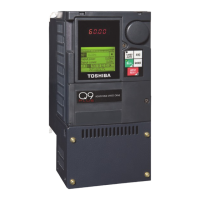16 https://www.toshiba.com/tic/
Installation and Connections
Q9 Plus ASD Install/Op Manual
(see F116). See F018 for more information on
preset speeds.
S3 — The default setting for this terminal is Damper
Feedback. The function of this input as Damper
Feedback is as a permissive for normal system
operation as described in Table 9 on page 252. The
S3 terminal is activated by connecting CC to this
terminal (Sink mode). This input terminal may be
programmed to any of the functions listed in Table 9
on page 252 (see F117).
S4 — The default setting for this terminal is
Emergency Off (Normally Closed). The Emergency
Off terminal is activated by opening the connection
to CC (Sink mode). The function of this input as
Emergency Off is to remove power from the output
of the ASD and may apply a supplemental braking
system using the method selected at the
Emergency Off Mode selection parameter (see
F603). This input terminal may be programmed to
any of the functions listed in Table 9 on page 252
(see F118).
RR — The default function assigned to this terminal
is the Frequency Mode 1 setting. The RR terminal
accepts a 0 – 10 VDC input signal that is used to
control the function assigned to this terminal. This
input terminal may be programmed to control the
speed or torque of the motor via an amplitude
setting or regulate by setting a limit. The gain and
bias of this terminal may be adjusted for
application-specific suitability (see F210 – F215).
See Figure 20. on pg. 19 for an electrical depiction
of the RR terminal. This terminal references CCA.
RX — The RX terminal accepts a ±10 VDC analog
input signal and controls the function assigned to
this terminal. This input terminal may be
programmed to control the speed, torque, or
direction of the motor. It may also be used to
regulate (limit) the speed or torque of the motor by
setting a limit. The gain and bias of this terminal
may be adjusted for application-specific suitability
(see F216 – F221). See Figure 20. on pg. 19 for an
electrical depiction of the RX terminal.
V/I — The V/I terminal has the dual function of
being able to receive an input voltage or current.
The function as a voltage input to receive a 0 – 10
VDC input signal. The function as a current input is
to receive a 0 – 20 mA input signal. SW301 must be
set to V or I to receive a voltage or current,
respectively (see Figure 9. on pg. 17). Using either
input type, the function is to control the 0.0 –
Maximum Frequency output or the 0.0 to 250%
torque output of the ASD. This is an isolated input
terminal. This terminal may be programmed to
control the speed or torque of the motor and cannot
process both simultaneously. Terminal scaling is
accomplished via F201 – F206. The gain and bias
of this terminal may be adjusted for application-
specific suitability (see F470 and F471).
+SU — Control Power Supply Backup input
terminal. This terminal accepts the user-supplied
24 VDC backup power to the control circuits (only).
Backup power is used in the event of an open
MCCB or during a momentary loss of the 3-phase
input power. Parameter settings, real-time clock
information, and trip history information are retained
with the use of the +SU backup power.
The Q9 Plus ASD is also equipped with an EOI-
mounted battery for this function. The battery
backup has the added feature of allowing for the
transfer of the EOI to another ASD while retaining
the control programming. See the section titled
Battery Backup on pg. 21 for more information on
the battery backup features.
P24 — +24 VDC at 200 mA power supply for
customer use. This terminal references CCA.
PP — The function of output PP is to provide a 10
VDC (10 mADC max.) output that may be divided
using a potentiometer. The tapped voltage is
applied to the RR input to provide manual control of
the RR programmed function. This terminal
references CCA.
O1A/B (OUT1A/B) — The default function
assigned to this terminal is Damper Command.
This output may be programmed to provide an
indication (open or closed) that any one of the
functions listed in Table 12 on page 257 has
occurred or is active. This function may be used to
signal external equipment (e.g., activate the brake)
(see F130). The OUT1 terminal is rated at 2 A/120
VAC and 2 A/30 VDC.
O2A/B (OUT2A/B) — The default function
assigned to this terminal is ACC/DEC Complete.
This output may be programmed to provide an
indication (open or closed) that any one of the
functions listed in Table 12 on page 257 has
occurred or is active. This function may be used to
signal external equipment (e.g., activate the brake)
(see F131). The OUT2 terminal is rated at 2A/120
VAC and 2A/30 VDC.
FP — The default function assigned to this open
collector output terminal is Output Frequency. This
output terminal produces an output pulse train that
has a frequency which is proportional to the
magnitude of the Output Frequency (or the function
S3
S4
RR
RX
V/I
+SU
P24
PP
O1A
O1B
O2A
O2B
FP

